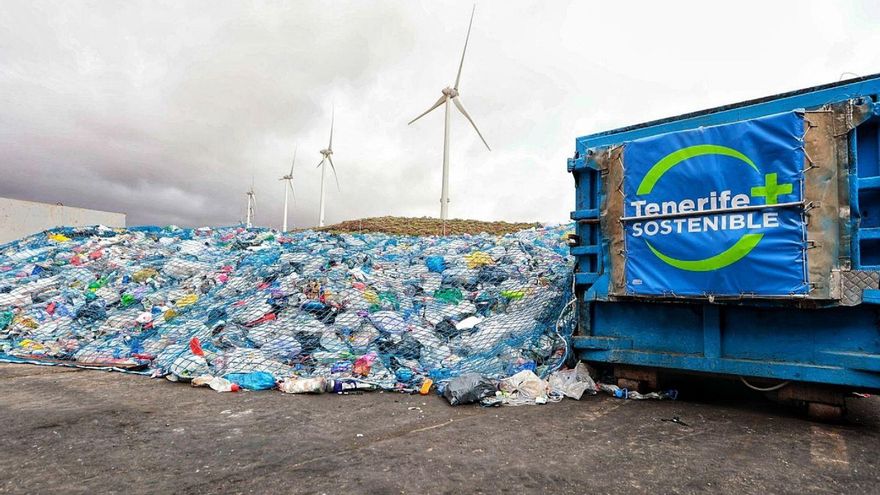
The Tenerife Waste Plan includes the planning and policies of the Island regarding the management of the waste generated on it. The goal is for it to be in line with the global strategies of the European Green Deal and the circular economy.
The Cabildo advances on this path, in which it is far from reaching the objective, through milestones such as the new contract for waste management. It was awarded in March 2021 for almost 400 million euros -the largest in the corporation’s history- to the Temporary Business Union (UTE) formed by Urbaser and FCC-Environment. It will take care of the waste generated, its deposit, elimination or recycling for 15 years.
The commitment includes improvement works in the Tenerife Environmental Complex (CAT), located in Arico. Two key objectives in the new vision of waste treatment: reward the least entry of garbage in the dumping cells (burial) and increase recovery percentages.
Waste management.
Island waste plans are similar to general urban planning plans. They establish a roadmap regarding new facilities, their possible locations and temporary development. In this sense, it is essential to address the management of organic matter through the fifth container, usually brown. Separation at source is a decisive step in the process. It is up to the municipalities to collect separately and there is still a long way to go in Tenerife, although an improvement is already beginning to be seen. The pilot plant in Arico to treat this type of waste will have to be completed with new facilities. In addition, the plan must also include the locations of new clean points and the possibility of creating transfer plants that complement the five that are already in operation, where the waste is compacted before being transferred to the CAT. This would reduce the ecological footprint by avoiding truck transfers to the island landfill. The document will analyze the measures and infrastructures to be implemented based on the population growth forecasts for the Island for the coming years, as well as its future tourism and industrial development. The Waste Master Plan regulates waste generated by activities carried out in Tenerife and its inhabitants to minimize negative impacts on the environment and health. The purpose is to avoid harmful and undesirable effects from an environmental point of view.
Prevention program.
The Waste Prevention Program for Tenerife Its purpose is to promote, as a basis for the circular model, prevention in the generation and the best use of products and materials. To this end, the promotion of actions that involve preventing, minimizing, sharing, renting, reusing, repairing, renovating, reusing and, in short, lengthening their life cycle by giving them greater added value is proposed. All these measures are focused on waste prevention, ecological design and reuse. In addition, they could save local businesses money, while reducing total annual greenhouse gas emissions and pressure on the natural environment, increasing the security of raw material supply, and stimulating competitiveness, innovation and growth. employment from the perspective of green growth. It can also provide consumers with more durable and innovative products that provide monetary savings and a higher quality of life.
legislated hierarchy.
Approving these documents will allow compliance with the waste hierarchy established in the Waste Framework Directive 2008/98/EC. This is the order of priorities: prevention, preparation for reuse, recycling, another type of recovery and disposal. The result is proper waste management and the achievement of a sustainable economy. The environmental assessment procedure is another step along the way. The Initial Strategic Document of the Tenerife Insular Waste Master Plan has been exposed and the competent administrations are now being consulted. After this period, all the observations, allegations and reports received from private citizens, entities, agencies and administrations. Subsequently, an Environmental Study is prepared which, together with the Plan, will once again be submitted for consultation and public information. The deadlines stipulated by the Law are met and it is estimated that in about four months these documents will be approved and the Strategic Environmental Declaration can be issued with which the process is closed. The Program and the Plan are valid for six years from their approval.
Third document.
The first Insular Solid Waste Plan was approved in Tenerife in the 1980s with powers in the management of waste centralized in the Cabildo. With the idea of adapting the regulations to the new parameters, the Tenerife Waste Plan was drawn up in 2009. This update is a boost to outdated legislation. This new document proposes a change of model and mentality to help stop seeing waste as waste and take advantage of it as a resource.
Material recovery, priority
The EU prioritizes material recovery (recycling) over energy recovery (converting waste into energy) in waste management. The objective is to reduce the generation of waste. Tenerife has resorted decades ago to the solution that Europe least advises: to accumulate the remains that cannot be reused in cells. Or bury. Of the 542,320 tons that CAT treated in 2019, 226,756 came from domestic waste generated by municipalities. Of these, 150,756, 60% went to dumping cells.















